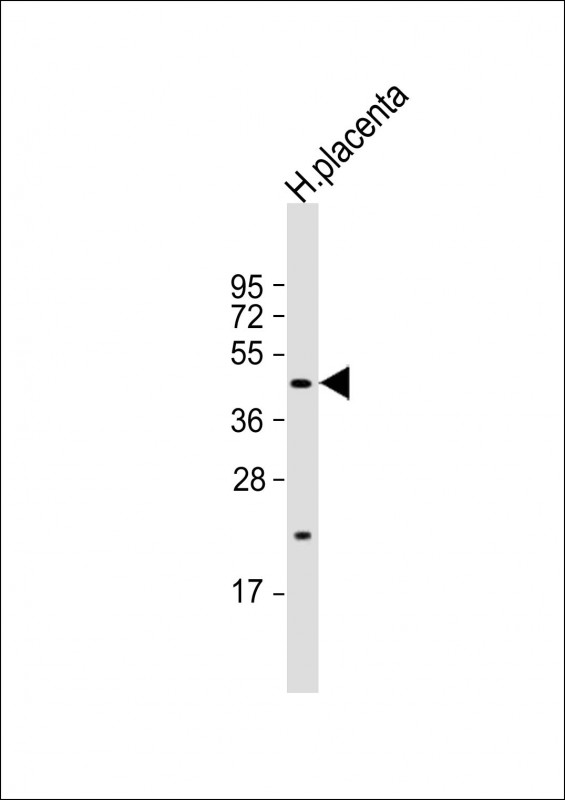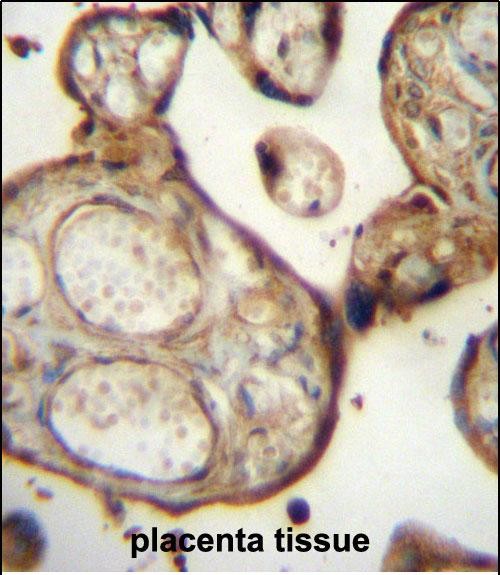Rabbit Polyclonal Antibody to SGPP1 (N-term)
货号:
P33734
别名:
Sphingosine-1-phosphate phosphatase 1, SPPase1, Spp1, hSPP1, hSPPase1, 313-, Sphingosine-1-phosphatase 1, SGPP1
应用:
WB,IHC
反应种属:
Human
抗体类型:
Primary antibody
Swissprot:
Q9BX95
规格:
目录价
在线咨询
Description |
|---|
Sphingosine-1-phosphate (S1P) is a bioactive sphingolipid metabolite that regulates diverse biologic processes. SGPP1 catalyzes the degradation of S1P via salvage and recycling of sphingosine into long-chain ceramides (Mandala et al., 2000 [PubMed 10859351]; Le Stunff et al., 2007 [PubMed 17895250]).[supplied by OMIM]. |
Specification |
|
|---|---|
| Aliases | Sphingosine-1-phosphate phosphatase 1, SPPase1, Spp1, hSPP1, hSPPase1, 313-, Sphingosine-1-phosphatase 1, SGPP1 |
| Entrez GeneID | 81537 |
| Swissprot | Q9BX95 |
| WB Predicted band size | 49.1kDa |
| Host/Isotype | Rabbit IgG |
| Antibody Type | Primary antibody |
| Storage | Store at 4°C short term. Aliquot and store at -20°C long term. Avoid freeze/thaw cycles. |
| Species Reactivity | Human |
| Immunogen | This SGPP1 antibody is generated from rabbits immunized with a KLH conjugated synthetic peptide between 13-42 amino acids from the N-terminal region of human SGPP1. |
| Formulation | Purified antibody in PBS with 0.05% sodium azide. |
Application |
|
|---|---|
| WB | 1/1000 |
| IHC | 1/100-1/500 |
Product Image
-
Anti-SGPP1 Antibody (N-term) at 1:1000 dilution + human placenta lysate Lysates/proteins at 20 µg per lane. Secondary Goat Anti-Rabbit IgG, (H+L), Peroxidase conjugated at 1/10000 dilution. Predicted band size : 49 kDa Blocking/Dilution buffer: 5% NFDM/TBST.

-
SGPP1 Antibody (N-term) (Cat. #P33734) western blot analysis in NCI-H292 cell line lysates (35ug/lane).This demonstrates the SGPP1 antibody detected the SGPP1 protein (arrow).

-
SGPP1 Antibody (N-term) (Cat. #P33734)immunohistochemistry analysis in formalin fixed and paraffin embedded human placenta tissue followed by peroxidase conjugation of the secondary antibody and DAB staining.This data demonstrates the use of SGPP1 Antibody (N-term) for immunohistochemistry. Clinical relevance has not been evaluated.







 鄂公网安备42018502007531号
鄂公网安备42018502007531号

